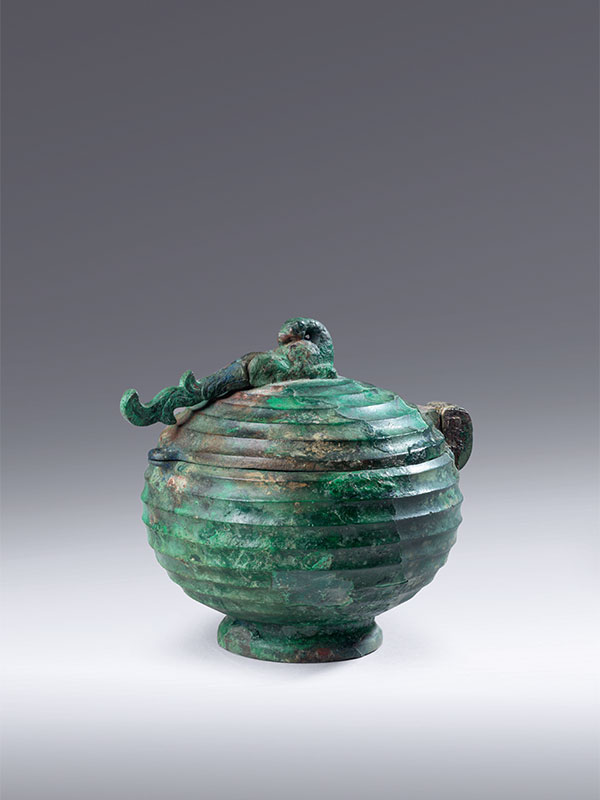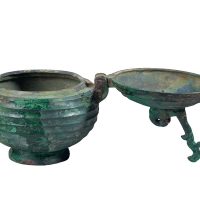Bronze folding oil lamp
China, Eastern Zhou dynasty, Warring States period, 475 - 221
A bronze oil lamp of globular form, standing on a short, tapered foot, and with a hinged domed lid. The body is decorated with broad horizontal grooves. The finial of the lid is formed by a sitting phoenix, its long tail hinged, and acting as a strut upon which the lid rests when open. The details of the bird’s feathers are minutely rendered. Inside the centre of the lid there is a sharp short protruding spike. Two small loops are attached to bowl and lid at the point where they meet, to enable the lid to be secured. A green patina, suffused with small areas of red and brown encrustation, covers most of the surface.
Small, box-like oil lamps such as this charming example, were presumably intended for travel; the actual lamp could be folded away and the lid securely fastened to the bowl whenever it was necessary to move it around. The earliest datable bronze lamps come from Warring Sates tombs. They were valued for their mythological imagery and helped to depict the cosmos within the tomb[1]. They were also meant for storing light into the after life. Folding lamps from this period are rare; most Warring States bronze lamps are simple stemmed dishes or take the form of a figure holding a lamp on a long shaft. A comparable, somewhat larger example was excavated from the tomb of a Zhongshan king, near Pingshan in Hebei Province in 1976[2]. Zhongshan was a powerful state in the Warring States period and played an important role in its history[3]. This lamp has a simple hinged loop finial instead of the beautifully detailed bird on the present example. Folding lamps occur more frequently in the subsequent Han dynasty (206 BC – 220 AD), when they often take the form of an animal, such as the buffalo in the Sze Yuan Tang collection[4]. In this case, the lid rests on the top of the animal’s head.
Provenance:
Ben Janssens Oriental Art, April 2003
Private Collection, UK
- Rawson, J. (ed.) Mysteries of Ancient China, New Discoveries from the Early Dynasties, British Museum Press, London 1996, p. 158
- Zhongguo Qingtongqi Quanji (Complete Volume of Chinese Bronze Objects),Vol. 9, Beijing 1995, no. 177, page 182
- Warring States Treasures – Cultural Relics from the State of Zhongshan, Hebei Province, Hong Kong 1999, p. 23
- Lee, X.q, The Glorious Traditions of Chinese Bronzes by Li Xueqin, Singapore 2000, no. 92, pp. 202-3


